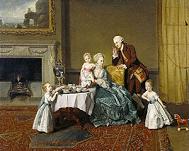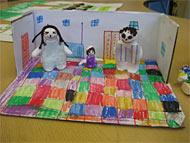 |
 |
 |
 |
Grades/Level: Lower Elementary (K–2)
Subjects: Visual Arts, English–Language Arts
Time Required: 3–5–Part Lesson
Three 30–45-minute class periods
Author: Nora Felix and Linda Murata, Elementary School Teachers
Lorena Street Elementary School, Los Angeles Unified School District
Permissions: 
The lesson plan and downloadable materials on this page are licensed under a Creative Commons Attribution 4.0 International License. |
 |
|
 |
 |
 |
 |
 |
 |
 |
Lesson Overview |
 |
|
 |
Students will analyze and describe a painting depicting a family. They will discuss similarities and differences between the setting of the painting and where they live. Then students will create a sculpture of their family doing an activity together and also create a diorama of a room in their home. |
 |
 |
 |
 |
 |
Learning Objectives |
 |
 |
Students will be able to:
• describe and identify character and setting in a painting of a family portrait.
• orally describe a painting in complete, coherent sentences.
• create a sculpture of their family.
• create a diorama setting for their family sculpture.
|
 |
 |
 |
 |
 |
 |
 |
 |
Materials |
 |
• Reproduction of John Fourteenth Lord Willoughby de Broke, and his Family by Johann Zoffany
• Crayola® Model Magic®
• Markers
• Scraps of fabric or colored paper
• Assorted materials to create settings (e.g., construction paper, tissue paper, stickers)
• Shoeboxes or cut-out cereal boxes premade by an adult (should have three sides and an open fourth side that extends)
|
 |
 |
 |
 |
 |
|
|
 |
 |
 |
 |
 |
Lesson Steps |
 |
Part 1: Art Inquiry
1. Display a reproduction of John, Fourteenth Lord Willoughby de Broke, and his Family by Johann Zoffany. Ask students to think-pair-share with their partners and describe the painting. They should begin by saying, "I see __________."
2. In a class discussion, ask the following questions and chart responses:
• What do you notice about the people in the painting?
• What are the people doing? What do you see that makes you say that?
• What do you notice about their clothes?
• What do you notice about the setting?
Part 2: Model Magic® Family
1. Review the reproduction of the Zoffany painting with students and focus the discussion on characters and family. Ask students the following questions:
• Who are the parents? How do you know?
• How big are the children in relation to the parents?
• What is the family wearing?
• What does your family wear?
2. Provide background about the artist for the students. Tell students that the artist Johann Zoffany was known for painting informal group portraits. The people in the painting look like they're in the middle of doing something together. Have students think-pair-share with a partner to answer the question:
• What does your family like to do together in your home?
3. Ask a few students to pick one family activity and share it with the class. Select students to dramatize their family activity for the class and mimic the body positions of their family members in the activity.
4. Hand out Crayola® Model Magic® to students and have them explore the properties of the clay. Discuss the various forms that can be used to create a human body (e.g., spheres/balls for heads; cylinders for arms and legs; and cubes, pyramids, or prisms for the torso). Use grade-appropriate vocabulary.
5. Instruct students to make body parts with clay. First, tell them to create spheres (or balls) for the head. Next, tell students to make cubes, pyramids, or prisms for the body. Lastly, have students create cylinders (or snakes) to make the arms and legs. Have students put all of the parts together to create clay sculptures of themselves and family members. Instruct students to think about the size and body positions (e.g., sitting, standing, dancing) of parents and siblings when creating. Refer to the reproduction of the Zoffany painting again, if necessary.
6. After students have created their family sculptures, allow the Model Magic® clay to dry for at least 24 hours.
7. Pass out markers and have students draw faces and hair on their clay sculptures. Provide scraps of fabric or paper and ask students to create clothing for their sculptures.
Part 3: Building a Setting
1. Review the reproduction of the Zoffany painting with students and focus the discussion on setting. Ask students the following questions:
• What do we see in the painting that tells us about the setting?
• What is the family doing in this room?
• What room could this be?
• Where do you eat in your house?
2. Tell students to share with a partner the family activity they chose during the class discussion in Part 1. Ask pairs to discuss where in their home they do that activity—and what that room looks like. Have students tell the class what they and their partners shared.
3. Hand out boxes, markers, construction paper, tissues paper, stickers, and other art materials.
4. Tell students to pair-share what details they will include in their "room." Point out that Zoffany included two tables, chairs, plates, etc. to give us clues about the room in which the family is sitting. Have students create their room in the diorama box. This is their home setting.
5. Have students arrange the family sculptures in their diorama to show their family enjoying an activity together.
6. Then ask students to share and describe their family, a favorite family activity, and the setting to the whole class.
7. Allow students to walk around and look at each other's artwork. |
 |
 |
 |
| John, Fourteenth Lord Willoughby de Broke, and his Family, Johann Zoffany, 1766 |
 |
|
 |
 |
 |
 |
 |
 |
 |
Assessment |
 |
Students will be assessed on their ability to describe and identify character and setting in a painting of a family portrait and orally describe a painting in complete, coherent sentences. Students' sculptures and dioramas should represent their families and homes. |
 |
 |
 |
 |
 |
Extensions |
 |
Have students create a family tree depicting all members of their family.
Read the story "The Lonely Prince" by Max Bolliger in the Open Court®textbook as it relates to the Zoffany painting. Children can discuss the similarities and differences between the family in the story and the family in the painting.
|
 |
 |
 |
 |
 |
 |
 |
 |
 |
Standards Addressed |
 |
Common Core Standards for English Language Arts
Grades K–2
SPEAKING AND LISTENING
K.1 Participate in collaborative conversations with diverse partners about kindergarten topics and text with peers and adults in small and larger groups.
K.4 Describe familiar people places, things, and events, with prompting and support, provide additional detail.
1.3 Ask and answer questions about what a speaker says in order to gather additional information or clarify something that is not understood.
1.6 Produce complete sentences when appropriate to task and situation. (See grade 1 Language standards 1 and 3 for specific expectations.)
2.1 Participate in collaborative conversations with diverse partners about grade 2 topics and text with peers and adults in small and larger groups.
2.4 Tell a story or recount an experience with appropriate facts and relevant, descriptive details, speaking audible in coherent sentences.
Visual Arts Content Standards for California State Public Schools
Kindergarten
2.0 Creative Expression
2.7 Create a three-dimensional form, such as a real or imaginary animal.
3.0 Historical and Cultural Context
3.2 Identify and describe works of art that show people doing things together.
English–Language Arts Content Standards for California Public Schools
Kindergarten
Reading
1.0 Word Analysis, Fluency, and Systematic Vocabulary Development
1.18 Describe common objects and events in both general and specific language.
3.0 Literary Response and Analysis
3.3 Identify characters, settings, and important events.
Listening and Speaking
1.0 Listening and Speaking Strategies
1.2 Share information and ideas, speaking audibly in complete, coherent sentences.
2.0 Speaking Applications
2.1 Describe people, places, things, locations, and actions.
|
 |

|
 |
 |
 |




